#Paifang
Explore tagged Tumblr posts
Text

Friendship Archway, Chinatown DC | ©inyoureyes69 | Linktree
55 notes
·
View notes
Photo

Friendship Archway
11 notes
·
View notes
Text

Paifang - Montréal Chinatown
#paifang#Chinatown#Montreal#Montreal Chinatown#Quartier Chinois#Quartier Chinois de Montreal#sky#photography
3 notes
·
View notes
Photo

Be sure to highlight yourself in everything… 👤⚡️🖼️ • #photography #curvecfd #paifang #archway #filter (at Manchester, United Kingdom) https://www.instagram.com/p/Cp_FgJMoWQQ/?igshid=NGJjMDIxMWI=
1 note
·
View note
Photo

Chinatown
1 note
·
View note
Text



Part 5
#if the paifang looks familiar please remember:#This is a work of fiction. Any resemblance to actual persons/places/events that was is or ever will be is purely coincidental#anyway i had to borrow the bricks#drawing what essentially a grid was not cutting it#wukong#sun wukong#jttw#journey to the west#wukong x oc#black myth wukong#jttw: book of the wolf#my art#oc#fixed to add the lotus on the lunch box... i thought i did but oh well
21 notes
·
View notes
Text
Air Temple Island, the Water Tribes & the Real Life Influences that bring them together
I was gonna screenshot a post I saw and add it to my post but I don’t feel like giving that individual attention (and the 300+ notes they got), so I just decided to make my own standalone post debunking this narrative that air temple island is this fully air nomad brothel (yes they said this) with ZERO water tribe motifs which katara is forced to live in until aang passed away.
frankly it just reminded me of how little people in this fandom actually bother to analyze the actual content, instead preferring to write entirely made up scenarios of katara being reduced to an air nomad incubator along with dozens other female acolytes (yes they also said this lmao. also them acting like both male AND female acolytes weren’t living on the whole other side of the island 😭)
when in truth, i’ve come to find a lot of elements of both water tribes as well as traditional inuit elements across air temple island:
1. the paifang
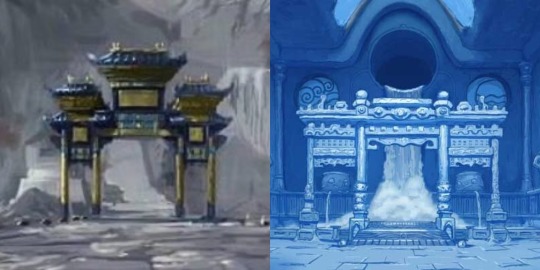
a traditionally chinese element that for some reason is exclusively found in the northern water tribe (why do they have a gate inside a throne room, you ask? ask the white people that made this show). the one on the left is actually one of two aang BUILT, at the main entrance and another at the temple entrance. this is just one example of water tribe design on the island.
2. the bagua mosaic
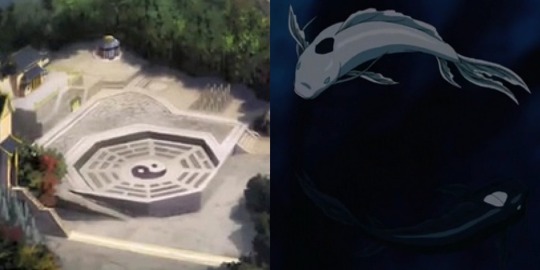
another structure is the bagua mosaic on the training grounds. bagua is a set of traditional chinese symbols of the cosmology, taoism. the bagua composes of 8 sets of broken or unbroken lines that represent yin and yang. where have we seen yin and yang in the original series? oh yeah, as tui and la of the water tribe! (because atla is a mess of asiatic and indigenous motifs joined together and spread out across each nation, mainly traditionally chinese elements at that.) aang building this right next to the air nomad training grounds is a symbol of the dual bending heritage their children will have.
3. gold and blue accents
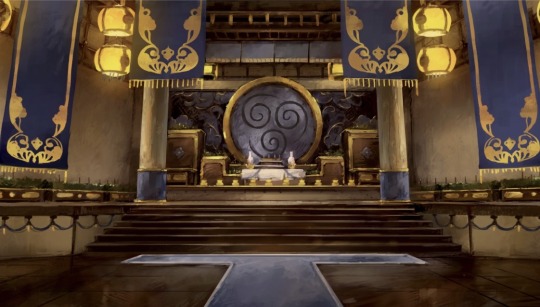
now, gold and blue are the main colors of the exterior structures but is also very strong inside the air temple itself. note, the massive air nomad symbol designed fully in blue in the center and the blue banners and rugs throughout the temple. this is no doubt, for me, a visual depiction of both katara and aang’s representative cultures, but of course this is not limited to color only.
4. cloud carvings
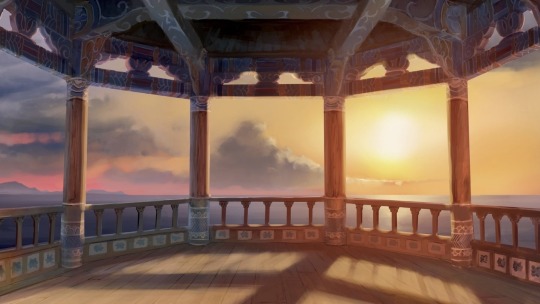
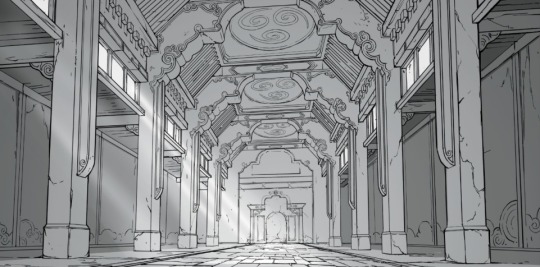
now, this is a slight detour since clouds aren’t a significant part of either of their individual cultures (that we know) but i love the kataang monopoly they have on clouds as a couple so i’m talking about it. if you look at these images very closely what do you see? CLOUD CARVINGS!! specifically near the ceiling of the pavilion (left) and the arches and walls of the temple (right) just imagining aang painting and etching these very consistent swirls, like he’ll never be the selfish inconsiderate unromantic loser you people want him to be, but let’s get more into the southern water tribe style interior.
5. interior design

so here is a southern water tribe white lotus outpost vs the air temple island main dining room. first thing, the seat cushions and rug! while we don’t see air nomad eating quarters we do get to see enough SWT customs both in atla and lok, to know this is how they traditionally eat compared to the north (limiting myself on pics cuz mobile).
another thing is the dining table itself. both have what i believe to be built in fire pits (i couldn’t actually tell for the air temple island one cuz of the quality but if you zoom in you can see the lines go in the table plus the hanging kettle on it makes it obvious to me idk). the southern water tribe one however is clear and likely a more traditional version of what aang and katara have.
thirdly, the exposed timber on the ceiling. i actually looked it up and found this is a common element of these two inuit structures: left is an aasiaat peat house and right is an igloolik turf house. all this for me to believe not only did aang build air temple island to be a haven for the TWO of them but also that katara herself had a lot of input on the interior than people care to notice lol.
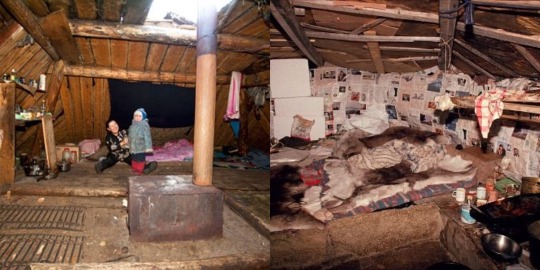
maybe instead of projecting these loser fantasies of katara being some unwilling air nomad baby making machine so you can feel better about your fantasies of katara living in a red palace with people that tried to wipe her out for a whole century, you all can go study the actual canon you were shown and the real life cultures the franchise takes from.
6. lastly, some of my own headcanons/stuff i want to see in the movie
the bathroom because I LIVE for a white marble tiled bathroom. i just know katara has to have a HUGE tub and they have one of those insane glass showers that can fit like 3 people, with cloud swirls everywhere because aang clearly got it like that
the KITCHEN, i imagine it being timber like the dining room and is probably on the other side behind the built-in shelf (get into the details like hello). in a perfect world, it would be open plan but hey
the bedroom, now we saw it in lok a bit but i wanna see it in the gaang movie too. i’m on pic limit but there’s a lot of artwork and flowers throughout the whole house which i give katara credit for because I can. like the desk, the bookshelf, that fancy looking vase thing? these two clearly have taste like don’t talk to me rn
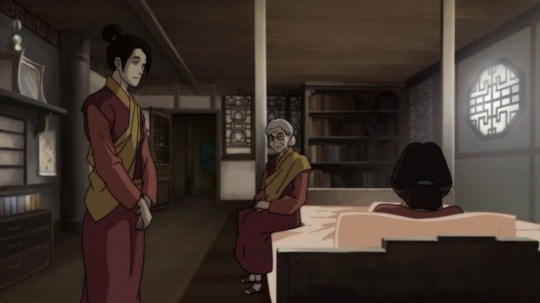
I also didn’t show the rooms and aang’s study but there’s a lot of blue decor in those places which makes me think katara decorated the whole house, even the acolytes’ hall has blue sitting cushions and columns which i think is such a nice detail.
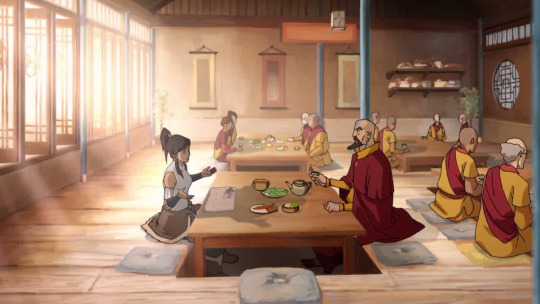
if you guys have any air temple island headcanons of your own please reply with some i’m feening lol
big shoutout to this user:
atla-annotated (their page is so great and filled with a lot of incredible information if you guys like this sort of stuff)
#atla#kataang#anti anti kataang#anti anti aang#aang the builder#i’ll keep saying it#anti anti katara#anti zutara#enough of with these loser fantasies#i’m sorry kataang will never have that cold sad narrative y’all desperately want them to#they need their own architectural digest house tour at this point#katara interior decorator fic when??#i need the hgtv kataang fic too btw#my fic ideas#my headcanons#air temple island#lok#cloudfamily#water tribe#air temple
243 notes
·
View notes
Text
Apr 11, Xi'an, China, Beilin Museum (Stele Forest) scenery:
The entrance:

A Chinese redbud tree (Cercis chinensis Bunge):

You can see fossils (the swirly thing) on the ancient stone pillars:
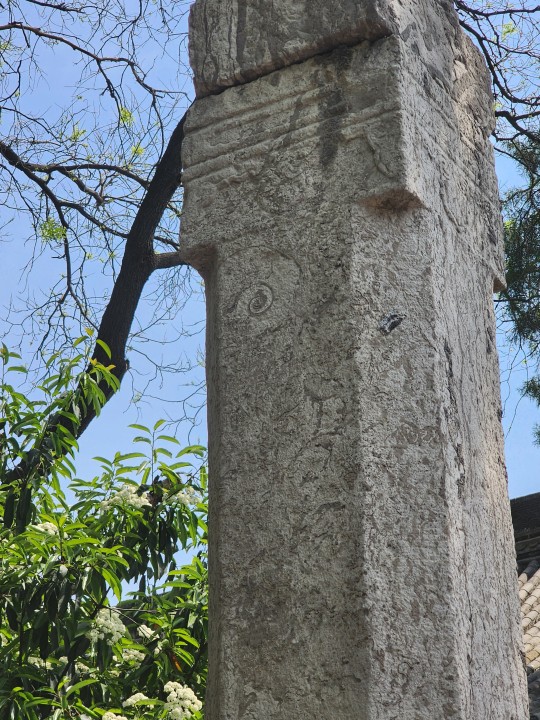
An old pavilion:
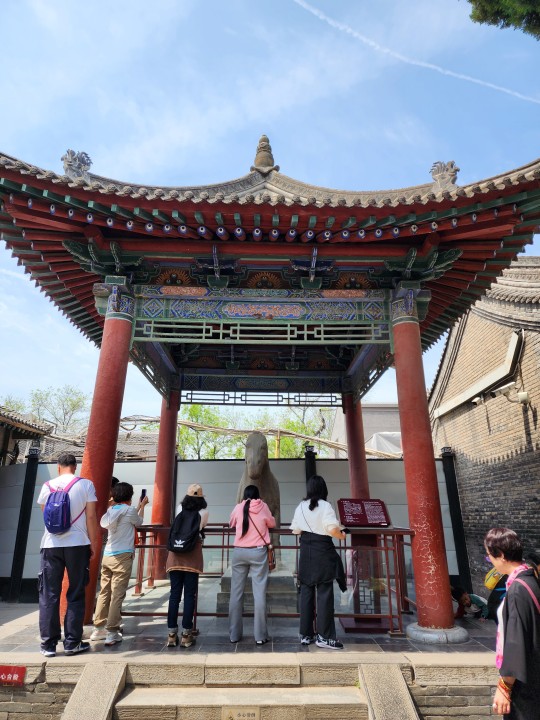
The inside of the roof of the pavilion:

A Qing-era pavilion housing steles that praised the emperor (locked, not open to public at the time):

Some species of maple tree?
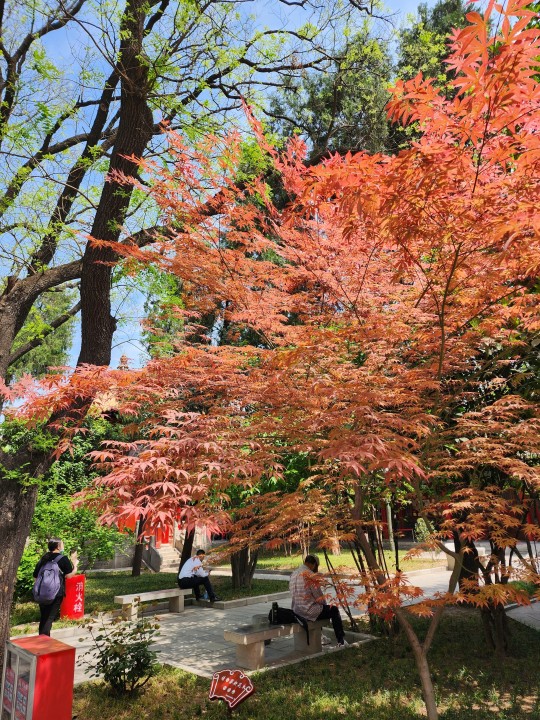
Beilin Museum is located in what was an ancient Confucian temple, thus the giant 孔廟 on the yingbi/影壁 wall:

The paifang/牌坊 of the original Confucian temple:
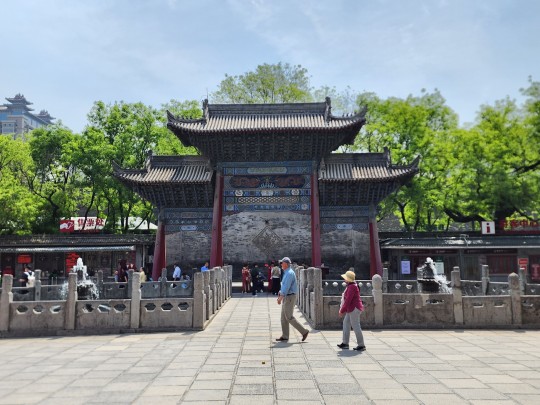

#2024 china#china#chinese history#chinese architecture#xi'an#beilin museum#stele forest#chinese culture
81 notes
·
View notes
Text
Let’s talk about Hong Lu’s poster
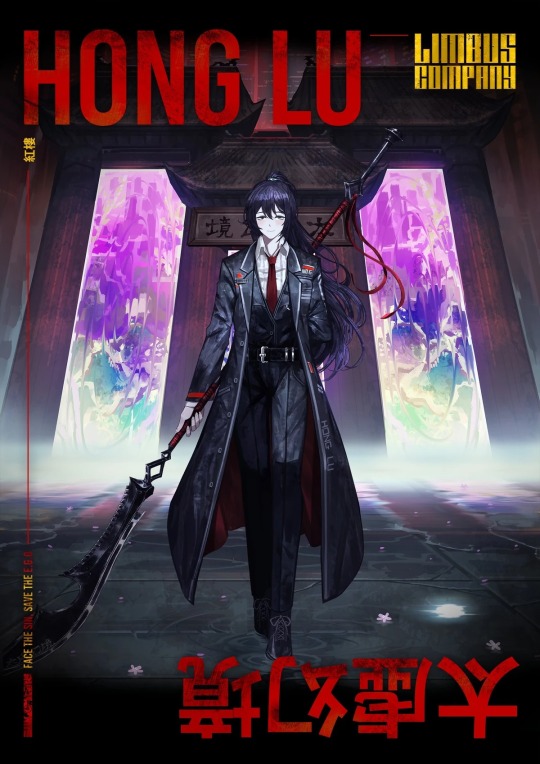
Summary:
Introduction
The paifang
Where is Hong Lu?
The reality of Hong Lu
{Skip the introduction if you’re only interested in the analysis of the character of Hong Lu and his poster}
I/ Introduction
Today I would like to offer you an analysis of Hong Lu's character poster. Although it is difficult to know what these character posters seek to show, apart from presenting characters, it is clear that each of them possesses clues about the sinners’ past and especially where the character represented comes from.
For example, we could see the pallid whale destroying the Pequod on Ishmael's poster, although it was easy to make the connection with Moby Dick, the poster also showed us that Ishmael had a history with a white whale and was a survivor of a shipwreck.
I am not sure if all the information is equally valuable according to the posters because, for example, Sinclair's poster is quite enigmatic and does not really show a specific event or place, or at least I do not recognize it.
But that does not stop me from believing that what is depicted behind the sinners is supposed to be related to the sinner, yes, but also, I think, related to a wing or place in the city that was important in the sinner's past.
I even wonder if the moment/place represented is not supposed to represent the place where the sinner decided to join the company.
Why do I say this? Well, you can see behind Rodion's character a casino setting, whereas her ego and space generated by the golden bough were affiliated with a world of ice. So why does Rodion's poster show her in front of an environment reminiscent of a casino? Perhaps it is to evoke her love for gambling as well as her ability to bluff and her desire for money, but if we look at Rodion's photo in the identity archive menu:

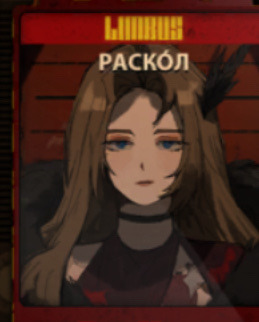
We can see Rodion in an outfit we have never seen her in before, an outfit that closely resembles what someone might wear at a casino. We have never seen how Rodion was recruited by Limbus Company, but if we follow the logic I just proposed, Rodion would have been recruited in a casino.
This logic seems credible and yet doubtful when we look at the case of Yi-sang.
For the moment, Yi-Sang is the only sinner whose recruitment by Limbus Company we know:
We know he was coming out of the laboratory where he was held by Gubo, the same laboratory we can see behind him on his poster.
But here's the catch: this is how Yi-sang was dressed when he met Faust VS versus what Yi-sang looks like on his photo in the identity archive:
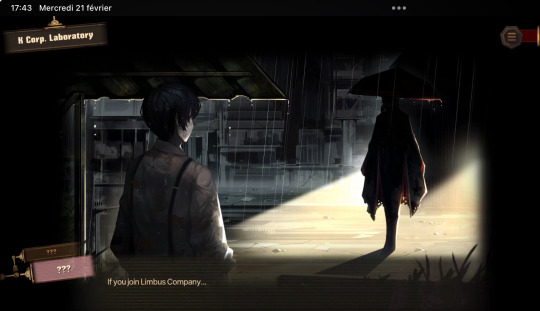
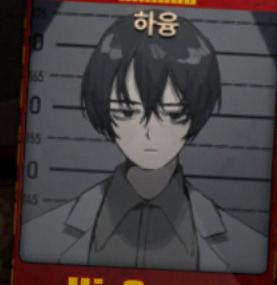
But hold on! I may have an explanation for this difference:
Yes, in the first image, Yi-Sang is not wearing his scientist coat, but he is indeed wearing the gray shirt, and I think Yi-Sang was indeed dressed with his coat initially, I think he just took it off in the left image.
So yes, it sounds like a lame excuse, but look at how Yi-Sang was dressed before this scene (when he was held captive).
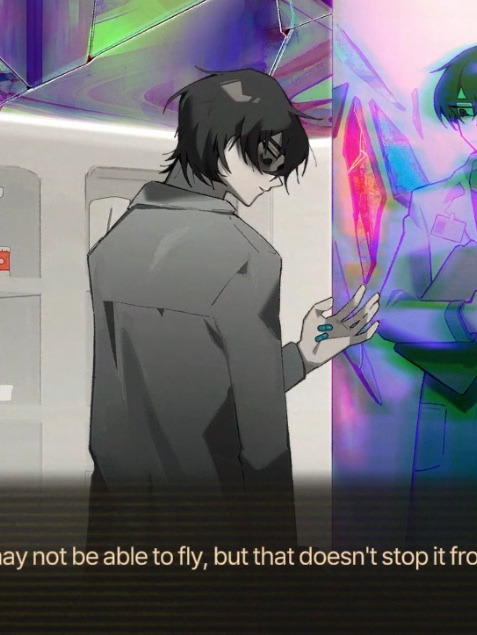
Boom, there it is, that scientist coat. Yi-Sang was indeed dressed as he was in that laboratory when his photo for the company was taken.
But here's the second little hiccup: we don't know how much time separates Yi-Sang's escape and his encounter with Faust...
But if what is depicted behind the sinners is not toward the place/moment where he was recruited by Limbus Company, then I think the place depicted behind the sinner is still a place/moment that shaped the sinner and convinced them to join Limbus Company.
II/ The Paifang
After this brief analysis that raised many questions, I would especially like us to keep the idea that what is depicted behind Hong Lu is related to him and the wing (or other place in the city) where he comes from.
Let's continue:
To make the understanding and analysis of the poster simpler, I decided to divide it into 6 zones:
Red: character
Dark blue: background area with tall buildings —> the city / what is behind the paifang
Purple: Paifang
Light blue: distorted and highly colorful area / portails
Orange: what surrounds the sides of the paifang
Green: the ground and what is in front of the paifang
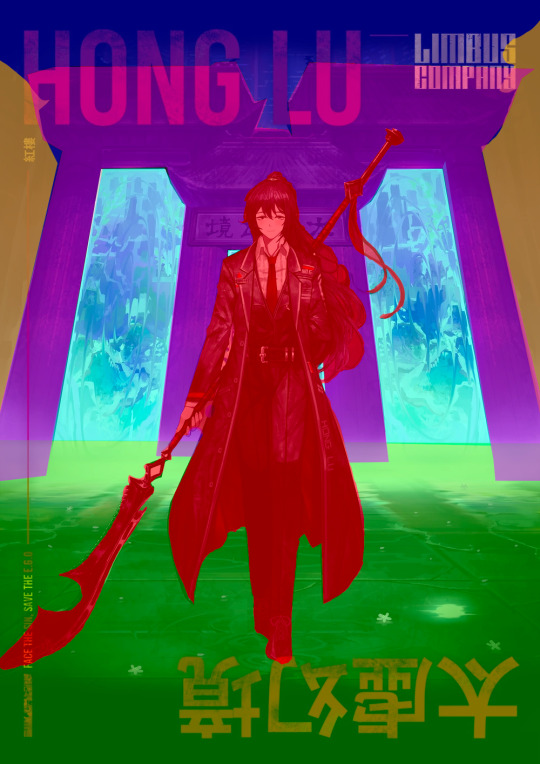
Even if sometimes I won't do it, I will now also use this color code to target specific areas of the poster when needed.
Well, first of all, I'm going to talk about the purple area, which is everything related to the Paifang, which is a very important element of this poster:
This Paifang, which looks like it's made of (red?) wood, seems to be surrounded by tall walls as we can see in the orange area.
So it seems that this Paifang is the only entrance and exit between two spaces. Indeed, if this Paifang is surrounded by walls and (assuming) they extend over a long distance, we can quickly conclude that this passage is the only one that could allow someone to enter or leave a closed space (we will come back to these ideas a little later).
Returning to the Paifang, it seems to perfectly fit the definition I found of a Paifang: "A Paifang is a traditional Chinese architectural structure in the form of a portico or arch, usually placed at the entrance of important places such as cities, temples, or properties. These symbolic gateways are often richly decorated and serve as monumental entry points."
I think the main idea to remember is that this Paifang is a gate/a means of passage, and I think it is the only gate allowing travel between the two spaces it separates.
But what does this gateway separate? Well, I think we have an answer with the inscription in the middle of this Paifang:

Indeed, what is written in the middle behind Hong Lu is this: 境幻虚太 (Jing Huan Xu Tai), we can recognize 4 distinct characters:
境: Realm
幻: Illusory
虚: Void
太: Great
But what is most surprising is that this phrase is actually written backward; indeed, in Chinese, it should be written 太虚幻境 (especially when we know what this combination means, especially in Dream of the Red Chamber), and here it is written as if it had been reflected in a mirror. We know that mirrors play a very important role in Limbus Company, but we will come back to this idea of a mirror a little later.
{Update : I was informed that the ordering of character written on the paifang is actually correct for traditional Chinese writing and for when the characters have to be placed horizontally (especially when you have to write on a space which does not really allow you to write in the vertical like on this paifan). The fact remains that the name of Hong Lu's weapon is therefore written in backward, so why? I don't really have an explanation now... and I have to admit that I still like my first analysis and I still think it is (a little) relevant in a way, so I invit you to keep reading (while keeping this in mind)}
For now, I would like to return to the meaning of what is written on this Paifang; indeed, once the combination of these 4 characters is reversed, it refers to a very important place in Dream of the Red Chamber: "Illusory Land of Great Void" or "Land of Illusion".
We can therefore conclude that this Paifang overlooks the "Land of Illusion" and separates/is the gateway between these two worlds, which are the "Land of Illusion" and, I think, the city.
Which is reminiscent of its “equivalent” in the novel since in the novel there is also a mention of a gate which separates the world of illusions from the rest or at least which indicates its entry point
{Side note: Strangely, this is not the only time that "太虚幻境" appears on the poster since it also appears just at the bottom right, and yes, "Land of Illusion" is also the name of Hong Lu's weapon, but that's not all! It is of course also the name of his EGO.
We can therefore see that the "Land of Illusion" is used to define many things related to or belonging to Hong Lu.}
In the novel Dream of the Red Chamber, The Land of Illusion is a domain where illusions and fantasies come to life. However, despite its enticing and enchanting appearance, this fictional world is also fraught with dangers and traps as it can lead individuals into deceptive illusions and prevent them from perceiving the truth.
However, a very interesting analysis of the Land of Illusion parallels this place with the Prospect Garden, which is the garden where Baoyu lives with his cousins and servants. It is the setting for many events in the novel and is also a haven of peace cut off from the rest of the world where its inhabitants can indulge in their idle and luxurious lives.
When Baoyu first visits this garden, he feels like he has been here before, and indeed, this garden actually reminds Baoyu of the place he visited in his dreams: the Land of Illusion.
A fantastical literary garden devoted to pleasure and love, which recalls the hero's dream of love and evokes in him a sense of the uncanny, will lead the reader to realize that Prospect Garden is the Land of Illusion. Eden, emptied of humanity, may remain a pristine ideal.
The Prospect Garden becomes a Buddhist allegory of experience. It blooms and withers with the ebb and flow of human desires and longings, but it is also a fictional world, imagined, the stuff of dreams.
The Prospect Garden is the earthly manifestation of the Land of Illusion, just as Baoyu is the physical earthly reincarnation of the stone.
III/ Where is Hong Lu?
After discussing what The Land of Illusion is and what this Paifang separated or rather where it leads to, it's time to ask a question: on which side is Hong Lu on his poster?
The Paifang already gives us an indication of this: since we can read "Land of Illusion" backward.
So I think we can deduce that Hong Lu is currently on the side of the "Land of Illusion" because if we follow the theory that the writing on the Paifang is reversed because Hong Lu is in a mirror world, then it's easy to guess that on the other side (the non-visible face) of the Paifang, we could read "The Land of Illusion" written correctly because this Paifang does lead to the "Land of Illusion."
To support this assertion (that Hong Lu is on the side of "The Land of Illusions"), I invite you to look at the dark blue area.
We can see tall buildings bathed in a red/black color; I think this modern aesthetic and these colors are supposed to remind us of the city, whose red color is often associated with —> just look at the map to notice this.
But that's not all: the color red is associated with the red dust by which Buddhism refers to the earthly realm, which contrasts sharply with the luxury brought to mind by the vernacular use of red.
Red dust is a symbol of the impermanence and transience of human life in Chinese philosophy.
It represents the reality of life as transient and ephemeral, reminding individuals that everything in this world is subject to change and disappearance. This notion is often used in Chinese literature and poetry to express the human condition and the importance of fully living each moment, knowing that nothing is permanent.
Red dust is used to talk about our world and our existence on it, which is but a short-lived illusion filled with suffering, to talk about the mundane world.
In Limbus Company, this world of Red Dust, this illusory world, is the city, and this bubbled paradise is "The Land of Illusion."
But how do we know that Hong Lu is indeed walking on the water of what I have been calling "The Land of Illusion" all this time?
Well, a clue might give us the answer; I invite you to look at the green area.
We can see that Hong Lu is walking on water, which already evokes the notion of "reflection" and this idea that The Land of Illusion is a mirrored world of the world of red dust, as is "The Land of Illusion" in the novel, but that's not all.
I will have to step away from Hong Lu's poster for a moment to look at an image present during the Limbus Company launch trailer.

Although nothing I'm about to say has been confirmed, I don't think it's too farfetched to say that we can see in this image a past version of Hong Lu, before he joined the company when he was at home, probably the Jia family manor (or at least its version of LCB).
What's interesting about this image is the color of the sky: this blue fading towards turquoise. We've seen it elsewhere before:

And yes! I am convinced that this blue space we can see in the cutscene of Hong Lu's EGO is supposed to be the sky from his home. And what is Hong Lu's EGO called? Land of Illusion.
Furthermore, I think that this blue sky is meant to contrast with the red sky of the city. Thus, the separation between the two is even more accentuated, as it was with the Paifang that clearly separated the two realities.
So, I believe that we can conclude that Hong Lu lives in the Land of Illusion.
This idea that the world in which Hong Lu lived is "The Land of Illusion" is emphasized by another detail: the reflection of the moon in the water.
In Buddhism, the image of the moon in the water is often used as a metaphor to illustrate the illusory nature of reality or the nature of conditioned existence. This metaphor is often associated with the practice of meditation and understanding the nature of the mind.
The moon in the water appears clearly and distinctly, but it is unstable and transitory, as it is subject to the movements of the water. Similarly, in daily life, what we perceive as reality is often changing, impermanent, and conditioned by multiple factors.
This metaphor thus emphasizes the importance of recognizing the illusory and impermanent nature of reality and not attaching to appearances or transient phenomena. In summary, in Buddhism, the image of the moon in the water is used to illustrate the illusory nature of reality and to encourage the practice of meditation and the search for the true nature of the mind.
I think that this image of the moon in the water is meant to make us understand the true nature of the place where Hong Lu walks: it is The Land Of Illusion, which is nevertheless Hong Lu's reality.
IV/ The Reality of Hong Lu
Indeed, I will now delve into an explanation, and I will try not to get confused. For this, we must now look at a very important excerpt when analyzing the novel Dream of the Red Chamber:
"Truth becomes fiction when the fiction's true; Real becomes not-real when the unreal's real."
This idiom is not just written anywhere in the world of the novel; it is located on the Paifang serving as the border and gateway to the Land of Illusion, and there is a good chance that it is also on the Paifang that we see behind Hong Lu.
This idiom makes us understand that reality is actually fiction and that fiction is actually the real world. It invites us to reverse our perception of realities and to consider what is called "real" as false and what is called “false” as real.
Here, I think, it is about understanding that Hong Lu's reality, which is (in) the Land of Illusions, is actually a fictitious and false world. Where the city, which is an unknown and completely foreign world to Hong Lu, which could be seen by him as a fictional world that is not real, is actually the real world, whereas the world he considers real is (his home) actually a false world.
To be honest, I cheated a bit because even though the reflection of the moon in the water is used to evoke a world of illusion for Buddhism, and even though I think it can indeed refer to the fact that Hong Lu is on the side of the "Land of Illusion", I think above all that this reflection is meant to make us understand that this world where Hong Lu is located has an illusory nature of reality + a nature of conditioned existence.
This brings me to talk again about Prospect Garden, which I think is the place where Hong Lu grew up but is especially the place from which Hong Lu must escape.
Prospect Garden is, as mentioned earlier, the Land of Illusion materialized in the real world and is therefore a domain where illusions and fantasies come to life, that is, a place where Baoyu bathed in luxury and idleness.
In "Dream of the Red Chamber," Jia Baoyu is often faced with symbolic choices between staying in Prospect Garden, which often represents the materialistic world and earthly pleasures, or setting out in search of spiritual enlightenment. His journey to enlightenment often involves leaving the illusions and distractions of the material world represented by Prospect Garden. Thus, it is often suggested that to achieve enlightenment, Jia Baoyu must move away from Prospect Garden and seek a true understanding of himself and the world around him.
At the end of the novel, Jia Baoyu (the figure who is supposed to have inspired Hong Lu) realizes the illusory nature of his life and realizes that Prospect Garden was only a world where he was trapped by the illusory pleasures of life, and that is why at the end Jia Baoyu decides to break with his previous life and leave the garden (as well as the rest of his family).
I think we are going to go to Hong Lu’s home to realise that he was literally living in a bubbled space and we will go to the Land of Illusion which, I think, will also be the Prospect Garden.
And the fact that the words are reverse like if they were reflected in a mirror helps, I think, to support on the idea that Hong Lu's world/reality is a reflection of the real world but where everything is distorted/inverted (a symbol I also think of Hong Lu's ignorance and his strange vision of the world) and that this illusion glass will break little by little
We also have to remember the sentence
"Truth becomes fiction when the fiction's true; Real becomes not-real when the unreal's real.
And remember that what is true is actually false / wrong according to this. So maybe, if this idea from the novel is kept, the world where Hong Lu is living is just a big lie where everything is just a smoke screen and that Hong Lu is living in denial, prefering to accept this illusion so that his world / vision of reality or truth is not shattered.
So, I think that Hong Lu, during his chapter, will have to understand that his reality is not true and learn to leave the land of illusion to find the truth because it seems to me that one of the theme of Hong Lu will turn around the theme of truth and reality.
#limbus company#hong lu lcb#project moon#analysis#theory#SN: I am so hype for Canto VI !!#so let's talk about Hong Lu while everyone else is talking about Heathcliff lol#of course it s just a theory and my interpretation#so I may be wrong or have misunderstood the character or even the book maybe#even if I really tried to do a maximum of research on the subject#Anyway I hope you'd enjoyed it !
117 notes
·
View notes
Text
Dragons Among Us Theory!!
Alright, KFP4 trailer is out and I have a couple of theories that all point to one similarity and that is; DRAGONS! Now, we all know this is the Year of the Dragon and all that jazz but this trailer takes it to another level from beginning to end so let's start how we always do here and press play; at the very start! We start with this Gate called a Paifang which is commonly used as an entrance for shrines, it can also be used for common structures and architecture but ssshh! Now, we all know this is the Year of the Dragon and all that jazz but this trailer takes it to another level from beginning to end so let's start how we always do here and press play; at the very start! We start with this Gate called a Paifang which is commonly used as an entrance for shrines, it can also be used for common structures and architecture but ssshh!
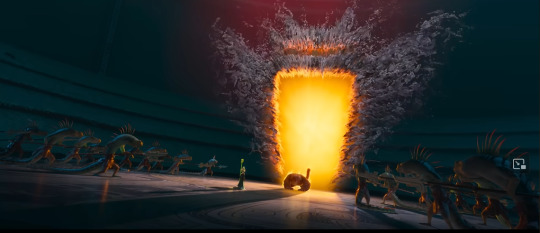
This gate is obviously made from natural materials such as burnt paper which is common practice in said shrines during the new year to make wishes along with Wood which is a Chinese element! So, we might have hints of chi manifesting into the elements of the mortal realm into something far more mystical than we have ever seen within the series! Now, this is closely connected to Dragons, dw I didn't forget! Our first hint is Tai Lung here, aka "The Great Dragon", he's only here for this one sole reason. (People aren't gonna like hearing this but he's gonna be the last bit of energy for what is to come!) The Chameleon cannot truly transform into others perfectly, there is always an imperfection such as when she transforms into the elephant which has designs upon her head on its trunk, Tai Lung has red pants instead of purple, and Po as we've all seen is rather spiky! This all leads to ONE THING, she is a shapeshifting Dragon! And one that fits this description is Shen/Chen in Chinese mythology and makes sense of those weird aquatic like Lizards in her army that match no know species we know of. Aka they are Dragons in disguise acting as normal lizards.
The second thing is her tail here. It grows rather than switches and flips and sheds scales of different colors as she did with Tai and Po, this I believe along with the shadow that follows is her true form.
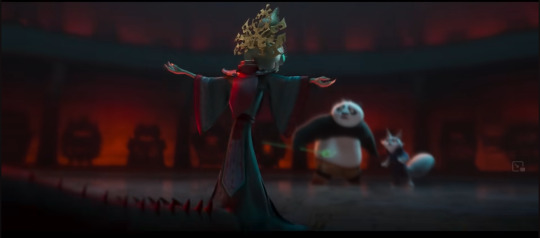
There could be a number of reasons why she wants Po's staff much less chi that aligns with the power much less essence of a Dragon because she is either a fallen dragon, an old god whose Shrine was left in the past by locals, or merely a Dragon wishing to ascend above what she is. It explains why the Director calls her more mystical than Kai, The Maker of Widows! She's an ancient being whose already tapped into chi and the nature around here along with knowing Dragon style already! And shoutout to my boy @thegreatying for telling me about Tibetan Temples cause I was confusing them with another type of Chinese temple so peep that info here!: https://en.wikipedia.org/wiki/Tibetan_Buddhist_architecture Honestly, this is going to be one of the best villains of this series with this concept alone, we are finally getting hints at Dragons and the door between the mortal realm and Heaven (aka the spirit realm) into the plot that continues on from what kfp3 left behind. The fact that chi is now normal and accessible makes beings like her look less special and less powerful. But gives her an opening for something even bigger than we could all expect!! So, that is my theory, that The Chameleon is just a code name for her taken form and that in reality, she is a shape-shifting Dragon and her army is also Dragons in disguise! With the themes of temples, shrines and maybe some commentary on Tourism in our future and how they affect old shrines and gods when we find it too inconvenient to visit them... Or maybe just maybe we'll get a hint at a true god-or maybe a Demi GOD YOU KNOW WHO IM TALKING ABOUT WUKONG! Anyways, that's all for now~!
#kung fu panda#kung fu panda 4#the chameleon#Po#Tai Lung#dragons#theory#fan theory#headcanon#kfp4#ThegreatYing#ya boy came out with the research#dont let anyone tell you fanfic research doesn't help#taylor talks#its still fuck awkwa in this house
46 notes
·
View notes
Photo


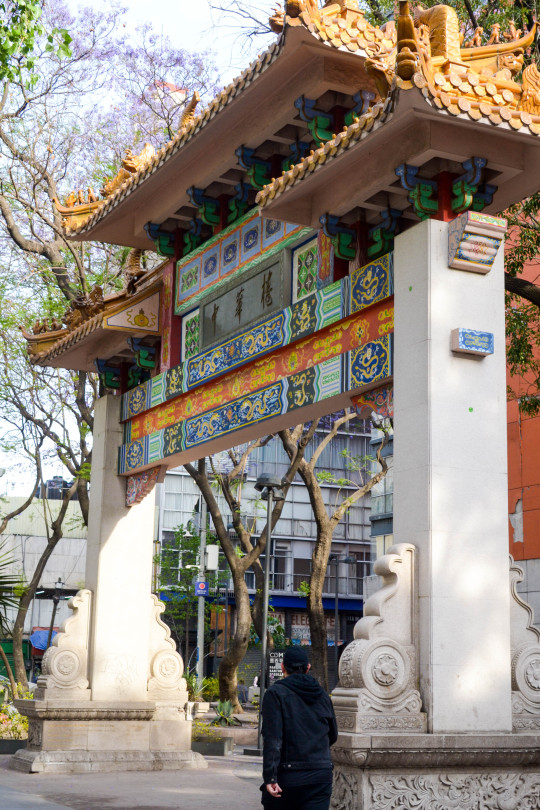

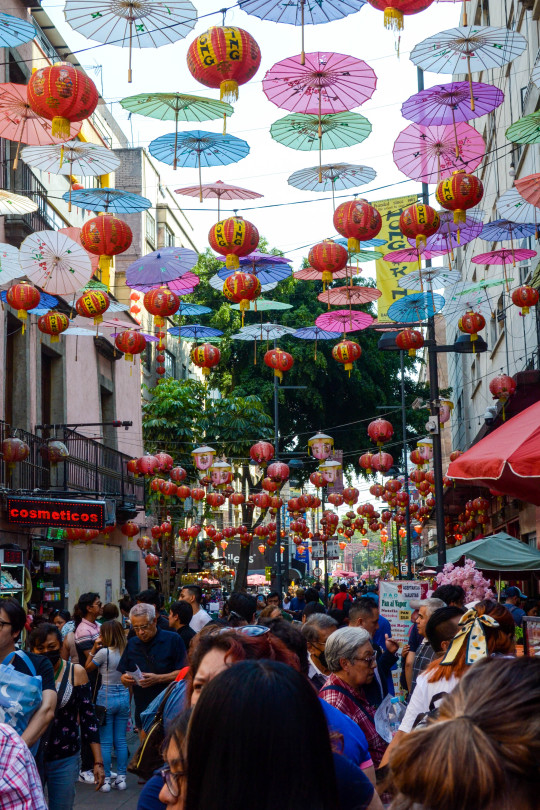

The Barrio Chino in Mexico City is only a few blocks away from where our hotel is, and it’s one of the smallest Chinatown neighborhoods in the world, but it’s so vibrant and pretty. There’s the main gate that you see off of Avenida Juarez that takes you to the heart of it, but approaching it one block south on Avenida Independencia is a little more chill. Either way, checking out Santos Degollado Park to look at the paifang, or gate, that’s on prominent display, as is walking down the street with all of the wonderful paper lanterns and parasols.
7 notes
·
View notes
Text
Sydney Street Files: What's my goal?

I don’t think anyone has documented Sydney’s Chinatown as extensively as I have. I know, I know, it’s an odd boast, but anyone who wants to fight me on this claim can do so in the comments. I’m free game. I hope to find someone who’s spent more time and effort in this one location than me. It’s doubtful, but I believe in you Sydney. I believe.
Joke’s aside, I am making this blog to hopefully spark some interest among Sydney-siders to go out and explore your streets and capture what you see. Beaches are beautiful and everyone knows that. I love and appreciate landscape photography as much as the next guy, but no one can deny that the most interesting part of photography is realism, and no other genre of photography feels more *real” to me than street photography. Even the streets surrounding a beach can be filled with so much untapped life - just get out and run with it!
Street photography can be fun, exciting, random, political, artistic, boring as all hell! It can be whatever you want it to be and that’s why I love every aspect of it. The process of stepping out into new or unfamiliar territory, knowing that you’ll run into something or someone you’ve seen a hundred times before or never in your entire life, is challenging but rewarding.
It’s all about embracing the random… Even posed photographs of complete strangers can feel candid at the moment because you’re exposing the random nature of human interactions. A man came up to me today in Haymarket, started singing something relating to Buddhist spirituality, and then proceeded to take off his shirt, pick up a National Geographic and pose on top of one of the Chinese guardian lions lining one of Dixon Street’s famous Paifangs (Chinese-style gates).
Did I ask him to? Of course not! My anxious brain was thinking “what the hell is happening?!”. But rather than pushing this eccentric guy away and asking him to chill the eff’ out, I ended up having one of my favourite photographic memories to date. It’s all about embracing the random and letting yourself just be in the moment, and that’s what is so bloody awesome about street photography.
What can street photography do for you as a photographer? When I got my first camera in 2018, my photos were honestly really bad. I left New Zealand with one photo that I was sort of happy with. ONE. In one of the most beautiful countries on the planet. I hadn’t put the time or effort into knowing how to use my camera, make compositions, and edit. I was completely lost with way too much confidence in my own inexistent ability. Street photography changed quite a lot for me as a photographer and allowed me the confidence to eventually step into paid gigs and volunteer photography jobs.
Your first step is to learn that you will suck major ass when you first start your street photography journey. If anyone reading this is an experienced photographer then I am sure you can attest to that, regardless of what genre of photography you really enjoy.
Make sure you set small goals for yourself and don’t put too much pressure on yourself early on. You will learn a lot with time, so here are some of the things that really helped me improve:
Going out to the same location over and over again (Chinatown for me) and shooting the same photo over and over and over and over and over again. You will learn how to get the best possible compositions if you try this. The best example for me is Chinatown’s famous clown guy who I have shot 50 times over and now I get a new picture I love nearly every time I see him
Talk to people! If you see a busker, have a chat and get to know who they are. In a few short minutes you can learn a lot about someone and how they got to where they are. Once you see them again, you’ll take a different photo every time and their comfort around the camera will grow ten-fold because you have already established a relationship with the subject. Forming a relationship with your subject can offer some awesome opportunities to practice composition. Once you have a good understanding of composition and framing your subject, you’ll find yourself keeping more photos than you would of when you first started your photography journey.
Find your editing style by editing the same image in 5 different ways. This is a great exercise I wished I had started earlier because I wasn’t critical enough of my own work. Looking back I would keep way too many photos that were ruined by bad editing, and then share them on my Instagram account. Now I don’t post nearly enough because I am maybe too critical. I promise there are more great photos coming dudes, bare with me as I am on my own journey myself and poor editing is a big reason why I have not posted so many pictures!
Stick with it. I will admit that street photography is very mentally challenging but keep on going back to the same spots and trying because someday soon it will be worth it. You’ll get there, just know that mistakes are good and you will keep picking up new skills as you go along. As clichè as it sounds - never give up.





#curators on tumblr#fujifilm#fujifilm photography#photooftheday#fujifilm x t3#photographer#photography#sydney#street photography#blog#blogger#bloggingcommunity#photography blog
1 note
·
View note
Text
2023/02/14
I had a dream where I travel back in time with a friend named Carlos, and we ended up in 1920’s China. The dream was all black and white, it’s as if I jumped into an old photograph. We got an invitation from the generalissimo himself, Chiang Kai Shek to go to his villa in Nanking. As we approached the entrance, a beautiful garden behind the paifang greeted us. There were two ornamental lion cubs on each side of the door, and on front of the villa sits two reflective pools of water with flower beds. Chiang led us to a bar and brought out a Chinese style tea set and did some gongfu cha for us. We chatted a bit, then asked us where we’re from. Me and Carlos didn’t know how to respond, but we said “from the future”. Chiang got all big eyed and was about to ask what China is like in the future. Before I could even react to the question, I woke up.
0 notes
Text


Guardian Lion and Paifang - Quartier Chinois, Montréal.
#photography#guardian lion#lion dog#paifang#Montreal#Chinatown#Quartier Chinois#street photography#urban photography
2 notes
·
View notes
Text
Cina. Il paese è allagato, resta in piedi la porta tradizionale in balia delle onde – Video
Le inondazioni causate da giorni di piogge torrenziali hanno sommerso strade e campi a Mentougou, un sobborgo rurale nella zona ovest di Pechino. Le immagini mostrano un ‘paifang’, la tradizionale porta di accesso cinese, in balia delle acque alluvionali. Alcuni video diffusi sui social media danno l’idea della dimensione catastrofica delle inondazioni che le precipitazioni più intense degli…
View On WordPress
0 notes
Photo

A gate in Beijing
191 notes
·
View notes